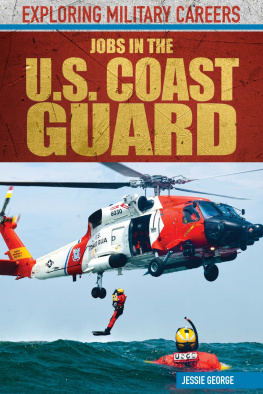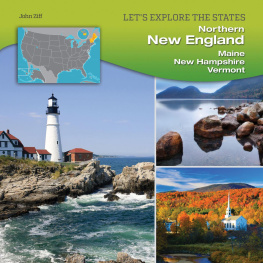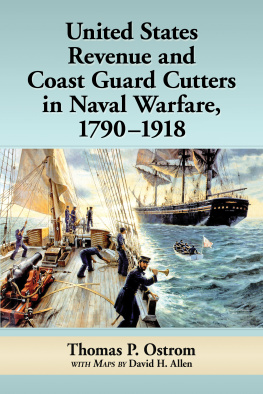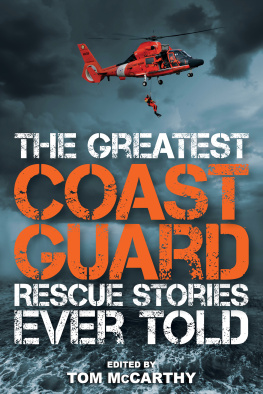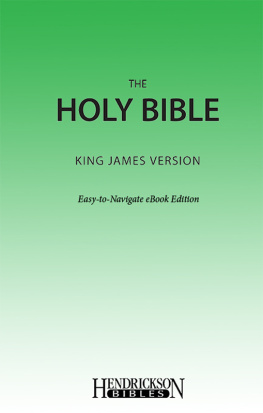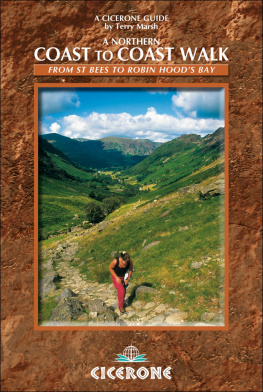Published by The History Press
Charleston, SC
www.historypress.com
Copyright 2020 by Dyke Hendrickson
All rights reserved
Front cover, top: Coast Guard members drill constantly on improving rescue techniques. U.S. Coast Guard photo; bottom: A Coast Guard vessel (right) is pictured with a rumrunning boat stopped during Prohibition times. U.S. Coast Guard photo.
First published 2020
E-book edition 2020
ISBN 978.1.43966.933.4
Library of Congress Control Number: 2019954279
print edition ISBN 978.1.46714.004.1
Notice: The information in this book is true and complete to the best of our knowledge. It is offered without guarantee on the part of the author or The History Press. The author and The History Press disclaim all liability in connection with the use of this book.
All rights reserved. No part of this book may be reproduced or transmitted in any form whatsoever without prior written permission from the publisher except in the case of brief quotations embodied in critical articles and reviews.
ACKNOWLEDGEMENTS
I want to express my appreciation to numerous people who helped with the framing, research and writing of this book. Thanks to Beth Welch for proofreading.
Individuals who were hugely helpful were Coast Guard members who participated in many personal interviews. After Rear Admiral Steven Poulin himself sat for an interviewand endorsed the projectCoast Guard members of all stripes were informative and helpful. I want to thank Admiral Poulin in particular. He was the commanding officer of First Coast Guard District (New England). He gave a great interview and opened doors so I could identify many vibrant Coast Guard professionals.
Others who provided thoughtful suggestions included Captain Andrea Marcille (ret.), Commander Valerie Boyd, Master Chief Jay Galazin, retired enlistee Ralph Stevens and Auxiliary instructor Joe Amore.
Appreciation also is extended to Joan Whitlow, executive director of the Custom House Maritime Museum in Newburyport, and to Michael Mroz, who is the former director there. I am currently the outreach historian for that institution, which is working to expand the reach of local history. The team at the Custom House Maritime Museum in Newburyport has enabled me to carry out valuable research.
Librarians and museum directors were helpful as well, including those in Rockland, Maine; Portland, Maine; South Portland, Maine; Portsmouth, New Hampshire; Newburyport, Massachusetts; Gloucester, Massachusetts; Barnstable, Massachusetts; New London, Connecticut; New Haven, Connecticut; and Burlington, Vermont.
Sharon Spieldenner, who heads the archive division at the Newburyport Public Library, identified valuable research materials.
Paul Roszkowski of the Coast Guards media services team in Los Angeles provided important material and introductions.
Assistance in providing research and/or logistical support came from generous souls including Jim Connolly, Jack Pramberg, Doug Muir, Kevin MacDonald, Joe Callahan, Ghlee Woodworth, Marge Motes, Skip Motes, Stewart Lyttle and the late Bill Plante.
Dot Black in Rockland, Maine; Rear Admiral Daniel May (ret.) of Newburyport, Massachusetts; and Kat Wedge from Dracut, Massachusetts, were very helpful. I hope to write profiles of them in the future. Others providing valuable background include Mark Cutter, Rob Craighead and Ron Booth, all of the Newburyport area.
My cousin and longtime sailor Malcolm Powell, of Norwalk, Connecticut, offered useful suggestions. He also provided a spare bedroom when I was researching in Connecticut or New York.
One great thank-you goes to those who supported my Kickstarter campaign in the early winter of 2018. This is an online application that permits a writer or artist to generate funds for creative projects. I raised close to $5,000 from fifty contributors, and I couldnt have gotten a good start if I didnt have this early financial support for travel and research materials. One of my frustrations, however, is the Kickstarter application did not provide the names of all contributors. Many were listed as anonymous. Thank you very much, even if I cant single you out by name!
Generous contributors include the following: Sadru and Clare Dunphy Hemani, Peter Wendell, Bob Connors, Dale Magee, Moss Quinlan, John Macone, Leslie Hendrickson, Drew Hendrickson, Natalia Martinez, Vicki Hendrickson, Wade Crowfoot, Dara Crowfoot, Jim Crowfoot, Josiah and Deirdre Welch, Andrew Mungo, Dr. Keith Ablow, Dr. Guy Navarra, Dr. Chad MacDonald, Paul Mills, Anne and Alec White, Tess Gerritsen, Jerry Lischke, Dr. Leif Bakland, Elizabeth Welch, Ron and Suzanne Rusay, Bob Richard, Brian Hotchkiss, Dr. Chandra Modi, Andre and Fontaine Dubus, Jacalyn Bennett, Geoff Nixon, Bruce Leonard, Ted Podkul, Rick Mesard, John Haass, Enzo DiMaio, Rob Mendel, John Burness and Dan Wagner.
Introduction
COAST GUARD SERVES NEW ENGLAND IN MANY WAYS
The U.S. Coast Guard is one of this countrys great waterborne assets. Coasties do much, and they are always there even if they do seem to function in the public shadow of the other armed services. The Coast Guard saves lives, patrols waterways, protects the marine environment, responds to natural disasters and much more.
Books have been written about the Coast Guard as an institution. But there have been few texts that provide profiles of those in uniform. In this book, members of the fifth service speak. Also, the history of the service is reviewed, with emphasis on what has happened in New England. The intent is to focus light on a service that does much and asks little in return.
The Coast Guard was founded in Newburyport, Massachusetts, in 1790, though the service was not known by that name until 1915. It has been known by several names, including the Revenue Marine and Revenue Cutter Service.
Much of its early history revolves around the six northeastern states, from northern Maine to southern Connecticut. The first of the services revenue cutters, the Massachusetts, was launched in that state in 1791.
The Life-Saving Service also has its roots in New England states, where many hearty lifesavers heeded the call, You have to go out but you dont have to come back. The Life-Saving Service and the Revenue Cutter Service were merged in 1915 to create the U.S. Coast Guard. The Lighthouse Service was melded into this organization in 1939 to form the modern Coast Guard as we know it.
This text provides profiles of those who have served here and explains the valuable work that they do. One important caveat must guide the reader: service members are transferred with regularity. An individual featured in New England Coast Guard Stories might be an officer or enlisted person who is no longer in the region. That means that a Boston-based admiral, such as Rear Admiral Steven Poulin, might have been interviewed in 2018, but he could be serving in Miami when you read this book. That is the case. Or master petty officer Lori Fields might have been in South Portland, Maine, and now finds herself in Hawaii. Yet everyone depicted here has a connection to New England. The goal is to convey the spirit and tone of the Coast Guard in the region.
The stations in the six New England states are part of the First Coast Guard District: New England, New York and northern New Jersey. This book focuses on New England, where many veterans are known as members of the D-1 Mafia. This refers to those who chooseor maneuverto serve hitches at stations in New England.


